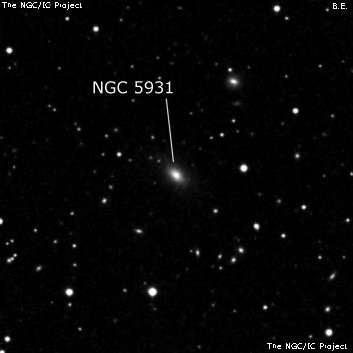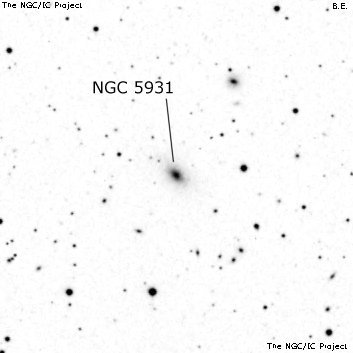NGC/IC Project Restoration Effort
(This is a very very beta version)
NGC5931


Basic Information
Location and Magnitude
Right Ascension: 15:29:29.6
Declination: +7:34:23
Constellation: SER
Visual Magnitude: 14.0
Historic Information
Discoverer: Swift L.
Year of discovery: 1887
Discovery aperture: 16.0
Observational
Summary description: eF, pL, R
Sub-type: S0
Corwin's Notes
=====
NGC 5931 is not IC 1122 as is sometimes assumed from the NGC and IC data and
descriptions. N5931 was found by Swift whose position for it is quite good.
This is the brightest galaxy in the area, one of the so-called "cD" galaxies
in a cluster. These objects average one to two magnitudes brighter than the
second brightest galaxy in the clusters, so they are often quite outstanding
from their several faint companions. This is certainly the case here since
N5931 is at least a magnitude brighter than I1122, the second brightest in the
cluster.
Next, Barnard, who was following an asteroid, ran across the brighter galaxy a
few years after Swift. Barnard made a micrometric measurement of it and
published it as a new object. His paper gives the position of his reference
star as well as the offsets to the galaxy. The star's position is good, but
the Dec offset is in error by 47 arcsec. This must reflect some sort of
reduction error in Barnard's calculations as it appears to be a random number,
not a clean digit error as we often see in the NGC and ICs. Fortunately,
Barnard's description of the object mentions an 11th magnitude star 1 arcmin
preceding. If we take the distance and magnitude of this star to be estimates
(the actual separation is 2 arcmin and the magnitude is 13), then the object
which Barnard saw is Swift's galaxy.
Finally, Bigourdan found a "nova" while measuring NGC 5931 (which he had no
trouble identifying; his position is within an arcsecond of the GSC position).
While Bigourdan's position for the new object is off by about 15 arcsec, he
comments that because the nebula is so faint, it was difficult to measure.
Even so, it is clearly a different object than NGC 5931, and so is not the
same "new" object that Barnard saw.
Dreyer, however, faced with a micrometric measurement from Barnard, and an
estimated position from Bigourdan (whose comparison star was not measured
until GSC), agreeing to within about two arcmin, did the logical thing and
adopted the micrometric measurement. So, the first IC includes the wrong
position for IC 1122, credits its discovery to Barnard as well as to
Bigourdan, and also includes Barnard's comment about the preceding star in the
description.
In actuality, IC 1122 is a separate galaxy found by Bigourdan and given a
pretty good position and description by him. I've adopted his object here.
Steve's Notes
=====
NGC 5931
24" (6/13/15): fairly faint, fairly small, slightly elongated SW-NE, 0.5'x0.4', weak concentration. A mag 12 star is 1.9' W. Forms a pair with IC 1122 is 3' NW.
17.5" (7/7/94): faint, small, round, 30" diameter, almost even surface brightness. A mag 12 star is 1.5' W and a mag 11 star is 3.4' SSE of center. NGC 5940 lies 28' ESE.



